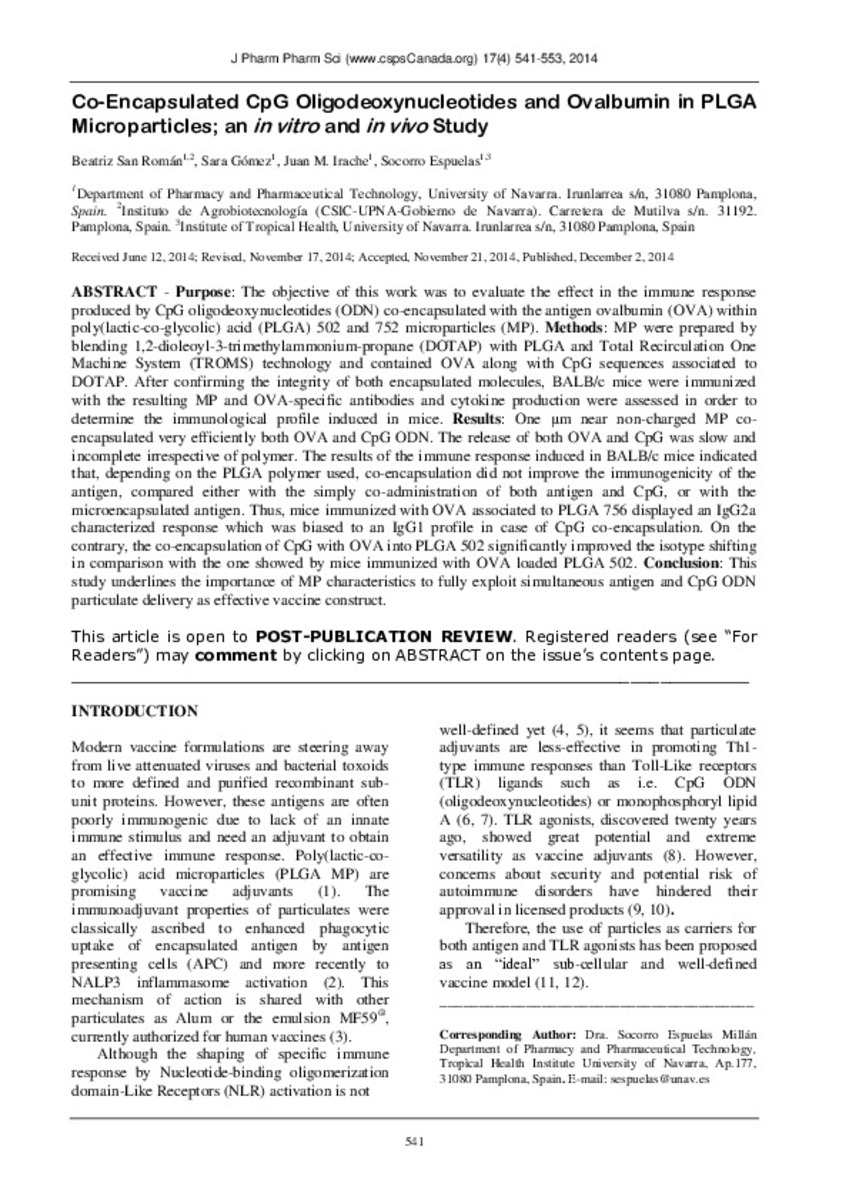Full metadata record
| DC Field | Value | Language |
|---|---|---|
| dc.creator | San-Roman, B. (Beatriz) | - |
| dc.creator | Gomez, S. (Sara) | - |
| dc.creator | Irache, J.M. (Juan Manuel) | - |
| dc.creator | Espuelas, S. (Socorro) | - |
| dc.date.accessioned | 2015-02-15T18:27:16Z | - |
| dc.date.available | 2015-02-15T18:27:16Z | - |
| dc.date.issued | 2014 | - |
| dc.identifier.citation | San-Román B, Gómez S, Irache J.M, Espuelas S. Co-encapsulated CpG oligodeoxynucleotides and ovalbumin in PLGA microparticles; an in vitro and in vivo study. J Pharm Pharm Sci 2014;17(4):541-553 | es_ES |
| dc.identifier.issn | 1482-1826 | - |
| dc.identifier.uri | https://hdl.handle.net/10171/37534 | - |
| dc.description.abstract | Purpose: The objective of this work was to evaluate the effect in the immune response produced by CpG oligodeoxynucleotides (ODN) co-encapsulated with the antigen ovalbumin (OVA) within poly(lactic-co-glycolic) acid (PLGA) 502 and 752 microparticles (MP). Methods: MP were prepared by blending 1,2-dioleoyl-3-trimethylammonium-propane (DOTAP) with PLGA and Total Recirculation One Machine System (TROMS) technology and contained OVA along with CpG sequences associated to DOTAP. After confirming the integrity of both encapsulated molecules, BALB/c mice were immunized with the resulting MP and OVA-specific antibodies and cytokine production were assessed in order to determine the immunological profile induced in mice. Results: One m near non-charged MP co-encapsulated very efficiently both OVA and CpG ODN. The release of both OVA and CpG was slow and incomplete irrespective of polymer. The results of the immune response induced in BALB/c mice indicated that, depending on the PLGA polymer used, co-encapsulation did not improve the immunogenicity of the antigen, compared either with the simply co-administration of both antigen and CpG, or with the microencapsulated antigen. Thus, mice immunized with OVA associated to PLGA 756 displayed an IgG2a characterized response which was biased to an IgG1 profile in case of CpG co-encapsulation. On the contrary, the co-encapsulation of CpG with OVA into PLGA 502 significantly improved the isotype shifting in comparison with the one showed by mice immunized with OVA loaded PLGA 502. Conclusion: This study underlines the importance of MP characteristics to fully exploit simultaneous antigen and CpG ODN particulate delivery as effective vaccine construct. | es_ES |
| dc.language.iso | eng | es_ES |
| dc.publisher | Canadian Society for Pharmaceutical Sciences | es_ES |
| dc.rights | info:eu-repo/semantics/openAccess | es_ES |
| dc.subject | Viruses and bacterial toxoids | es_ES |
| dc.subject | Immune response | es_ES |
| dc.subject | Vaccine | es_ES |
| dc.title | Co-encapsulated CpG oligodeoxynucleotides and ovalbumin in PLGA microparticles; an in vitro and in vivo study | es_ES |
| dc.type | info:eu-repo/semantics/article | es_ES |
| dc.identifier.doi | http://dx.doi.org/10.18433/J33892 | es_ES |
Files in This Item:
Statistics and impact
Items in Dadun are protected by copyright, with all rights reserved, unless otherwise indicated.






